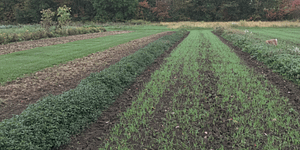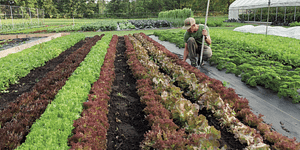Got Pie?

Thanksgiving is just days away and your pie-loving friends here at Chelsea Green thought we’d share with you one of our favorite fruit pie recipes.
The following apple pie recipe was adapted from Michael Phillips’ book The Apple Grower by the foodies over at The Washington Post and is named for Michael’s farm in northern New Hampshire. Make sure not to miss Michael’s newest book — The Holistic Orchard.
Michael recommends this pie for Thanksgiving, or other special occasions. In Vermont, we’re still picking over the last of the fall’s apple harvest in our coops so we have some fruit still worthy of being turned into pie.
Pay close attention to this recipe as it calls for cider jelly, which is a separate process that may require more time than your normal pie recipe. But, it’s well worth the extra work.
Lost Nation Cider Pie
This might be the sleeper among your holiday desserts. Lost Nation is a rural enclave in northernmost New Hampshire, near the Canadian border. Resident farmers Michael and Nancy Phillips hold an annual party at which cider from their apple orchards, and this pie, are served.
You’ll need enough pie dough, either homemade or store-bought, for a double-crust pie. Serve topped with a slice of sharp cheddar cheese or with a scoop of vanilla ice cream on the side.
MAKE AHEAD: The recipe calls for making cider jelly, which is done by boiling fresh apple cider to the jellying stage. The jelly may be made up to 5 days in advance, then covered and refrigerated. Alternatively, prepared cider jelly may be used.
If you’d like to make more than you need for this recipe, a gallon of fresh apple cider will yield about 2 cups of cider jelly. Store in sterilized canning jars.
Makes one 9-inch pie (8 servings)
Ingredients:
For the cider jelly
1/2 gallon fresh apple cider (see headnote; may substitute 1 cup store-bought cider jelly)
For the pie
homemade or store-bought pastry for a two-crust 9-inch pie
2 medium apples, such as Honeycrisp or Granny Smith, peeled, cored, cut in half, then cut into very thin slices
3/4 cup sugar
3 tablespoons cornstarch
Pinch salt
1/2 cup boiling water
1 egg, lightly beaten
1 tablespoon unsalted butter, melted and cooled slightly
Directions:
For the cider jelly: Pour the cider into a medium heavy, nonreactive pot. Bring to a boil over high heat. Use a candy thermometer to measure the temperature, which should come up to 220 degrees (the jellying stage). Boil until the cider has reduced to almost 1 cup, adjusting the heat and stirring as needed to avoid scorching. This can take from 75 to 90 minutes.
When the cider has reduced and thickened, remove it from the heat. Transfer to a heatproof container and cool to room temperature, then cover and refrigerate until ready to use.
For the pie: Preheat the oven to 425 degrees. Use the homemade or store-bought crust to line a 9-inch pie plate, folding under and pinching the edges to form a tidy rim. Arrange the apple slices on the surface of the bottom pie crust dough in flat layers. Have the top round of pie dough ready.
Combine the sugar, cornstarch and salt in a medium mixing bowl. Add the cider jelly and just-boiled water; mix well.
Whisk together the egg and melted butter in a liquid measuring cup, then add the mixture to the sugar-cider jelly mixture, stirring to combine. Pour the mixture carefully over the apples in the pie plate. Place the top crust on the pie; crimp the edges around the rim and use a knife to make several small cuts in the top (to allow steam to escape). Place the pie on a rimmed baking sheet (to catch any drips); bake for 40 minutes or until the top crust is golden.
Transfer the pie to a wire rack to cool for at least 20 minutes before serving.
Recent Articles
Want to make the most of the slow gardening season? Lay cover crops to improve the health of your soil and plants! The following is an excerpt from The Celestial Garden by Jane Hawley Stevens. It has been adapted for the web. Benefits of Cover Crops Cover cropping is a management practice that benefits the…
Read MoreInterested in micro-farming, but don’t know where to begin? Believe it or not, you only need 9 tools to get started. These easy-to-find tools for micro-farming will set the stage for productive growing! The following is an excerpt from The Lean Micro Farm by Ben Hartman. It has been adapted for the web. Unless otherwise noted, all…
Read MoreSeeds are the foundation of agriculture. As John Navazio describes in this excerpt, America was once home to hundreds of small-scale agricultural seed producers, each of which developed seeds adapted to grow best in the surrounding region. Today, following the trend of most businesses, just a few large companies provide seed for farmers everywhere. With…
Read MoreLooking for a veggie to grow and harvest through winter? Try leeks! With some careful planning, a bit of elbow grease, and some insight from Eliot Coleman, you’ll enjoy leeks from your garden all year long. The following is an excerpt fromThe Winter Harvest Handbook by Eliot Coleman. It has been adapted for the…
Read MoreWant to set up your own micro-farm? These tips will help you learn how to simplify your work, increase profitability, and shape your ideas so you can create the perfect tiny farm for you. The following is an excerpt from The Lean Micro Farm by Ben Hartman. It has been adapted for the web. Unless…
Read More








